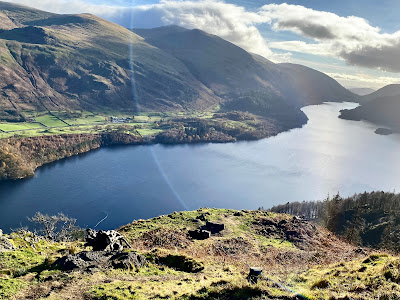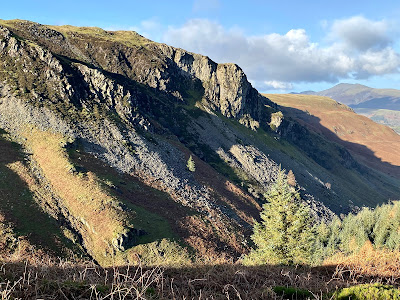 |
| Keswick and Skiddaw from Walla Crag |
Tuesday, 21 November 2023
Walk 1
Ascent: 152 metres,
Distance: 3 kilometres,
Total time 38 minutes
Walla Crag 376m 20mins
Walk 2
Ascent: 320 metres,
Distance: 5 kilometres,
Time 1 hour 25 minutes
Raven Crag 461m 39mins
Castle Crag 402m 50mins
The surprise was the blue skies over Keswick. The Met Office were wrong but we checked Helvellyn in case conditions had improved there since we had decided to give it a miss when planning our walk the previous evening. A mist-shrouded day was still predicted so we packed our stuff and decided to stick to some lower hills. While waiting for the others in the lounge, I was accosted by a lady who must have been in her late fifties and was on her own in the Youth Hostel. She admired my dirty yellow trail shoes and explained her love of walking and how she enjoyed walking with others. Fortunately, Keith and John arrived with their stuff so I could make my escape. The last time I was here as a teenager I was led astray by a similar incident, I had learnt something over the years.
Walla Crag is one of the lowest and easiest hills that Wainwright deigned to include in his guidebooks. We parked at Castlerigg just past the campsite that I had used on several occasions. The walk is not much more than a mile to the summit that overlooks Derwentwater and provides stunning views over Derwentwater and to Skiddaw and Blencathra, presumably why Wainwright gave it a status beyond its altitude, it is just a slog up a field. The views were worth the visit and as we scanned to the south, it was a relief to see that Helvellyn was still buried in deep clouds.
It is only a few miles along the A591 to Thirlmere. We headed for the dam where the circular road has now been closed. It gave us the chance to walk across the dam and admire the engineering works carried out by Manchester Corporation when they built the dam to secure water supplies for Manchester and much of Lancashire. It is a fine example of Municipal enterprise in the days when central government knew its place and didn't attempt to take over or privatise local infrastructure and facilities that were secured on local evidence of need. The provision was usually made in partnership with local companies, the sort of public/private partnership that has been bastardised by the top-down imposition of similar arrangements by recent governments but which are dominated by finance-driven national cartels.










No comments:
Post a Comment
thanks